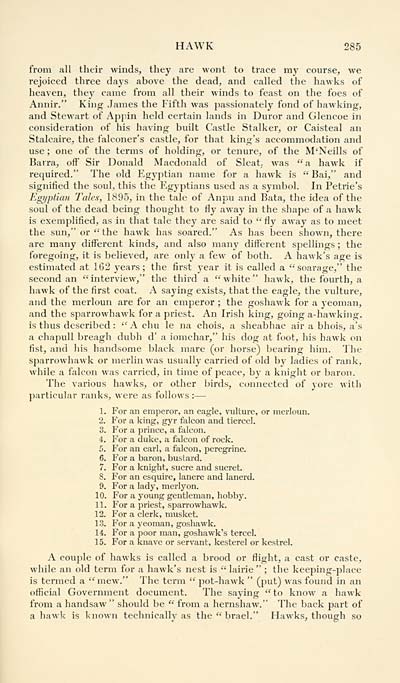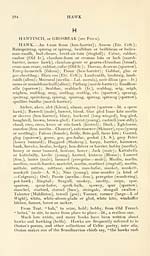Download files
Complete book:
Individual page:
Thumbnail gallery: Grid view | List view

HAWK 285
from all their winds, they are wont to trace my course, we
rejoiced three days above the dead, and called the hawks of
heaven, they came trom all their winds to feast on the foes of
Annir." King James the Fifth was passionately fond of hawking,
and Stewart of Appin held certain lands in Duror and Glencoe in
consideration of his having built Castle Stalker, or Caisteal an
Stalcaire, the falconer's castle, for that king's accommodation and
use; one of the terms of holding, or tenure, of the M'Neills of
Barra, oft' Sir Donald Macdonald of Sleat; was "a hawk if
required." The old Egyptian name for a hawk is " Bai," and
signified the soul, this the Egyptians used as a symbol. In Petrie's
Egliptian Talcs, 1895, in the tale of Anpu and Bata, the idea of the
soul of the dead being thought to fly away in the shape of a hawk
is exemplified, as in that tale they are said to "fly away as to meet
the sun," or "the hawk has soared." As has been shown, there
are many different kinds, and also many different spellings ; the
foregoing, it is believed, are only a few of both. A hawk's age is
estimated at 162 years; the first year it is called a '"soarage," the
second an "interview," the third a "white" hawk, the fourth, a
hawk of the first coat. A saying exists, that the eagle, the vulture,
and the merloun are for an emperor ; the goshawk for a yeoman,
and the sparrowhawk for a priest. An Irish king, going a-hawkijig,
is thus described: "A chu le na chois, a sheabhac air a bhois, a's
a chapull breagh dubh d' a iomchar," his dog at foot, his hawk on
fist, and his handsome black mare (or horse) bearing him. The
sparrowhawk or merlin was usually carried of old by ladies of rank,
while a falcon was carried, in time of peace, by a knight or baron.
The various hawks, or other birds, connected of yore with
particular ranks, were as follows : —
1. For an emperor, an eagle, vulture, or merloun.
2. For a king, gyr falcon and tiercel.
3. For a prince, a falcon.
4. For a duke, a falcon of rock.
5. For an earl, a falcon, peregrine.
6. For a baron, bustard.
7. For a knight, sucre and sucret.
8. For an esquire, lanere and lanerd.
9. For a lady, merlyon.
10. For a young gentleman, hobby.
11. For a priest, sparrowhawk.
12. For a clerk, musket.
13. For a yeoman, goshawk.
14. For a poor man, goshawk's tercel.
15. For a knave or servant, kesterel or kestrel.
A couple of hawks is called a brood or flight, a cast or caste,
while an old term for a hawk's nest is "lairie" ; the keeping-place
is termed a "mew." The term " pot-hawk " (put) was found in an
oflticial Government document. The saying "to know a hawk
from a handsaw" should be " from a hernshaw." The back part of
a hawk is known technically as the"brael." Hawks, though so
from all their winds, they are wont to trace my course, we
rejoiced three days above the dead, and called the hawks of
heaven, they came trom all their winds to feast on the foes of
Annir." King James the Fifth was passionately fond of hawking,
and Stewart of Appin held certain lands in Duror and Glencoe in
consideration of his having built Castle Stalker, or Caisteal an
Stalcaire, the falconer's castle, for that king's accommodation and
use; one of the terms of holding, or tenure, of the M'Neills of
Barra, oft' Sir Donald Macdonald of Sleat; was "a hawk if
required." The old Egyptian name for a hawk is " Bai," and
signified the soul, this the Egyptians used as a symbol. In Petrie's
Egliptian Talcs, 1895, in the tale of Anpu and Bata, the idea of the
soul of the dead being thought to fly away in the shape of a hawk
is exemplified, as in that tale they are said to "fly away as to meet
the sun," or "the hawk has soared." As has been shown, there
are many different kinds, and also many different spellings ; the
foregoing, it is believed, are only a few of both. A hawk's age is
estimated at 162 years; the first year it is called a '"soarage," the
second an "interview," the third a "white" hawk, the fourth, a
hawk of the first coat. A saying exists, that the eagle, the vulture,
and the merloun are for an emperor ; the goshawk for a yeoman,
and the sparrowhawk for a priest. An Irish king, going a-hawkijig,
is thus described: "A chu le na chois, a sheabhac air a bhois, a's
a chapull breagh dubh d' a iomchar," his dog at foot, his hawk on
fist, and his handsome black mare (or horse) bearing him. The
sparrowhawk or merlin was usually carried of old by ladies of rank,
while a falcon was carried, in time of peace, by a knight or baron.
The various hawks, or other birds, connected of yore with
particular ranks, were as follows : —
1. For an emperor, an eagle, vulture, or merloun.
2. For a king, gyr falcon and tiercel.
3. For a prince, a falcon.
4. For a duke, a falcon of rock.
5. For an earl, a falcon, peregrine.
6. For a baron, bustard.
7. For a knight, sucre and sucret.
8. For an esquire, lanere and lanerd.
9. For a lady, merlyon.
10. For a young gentleman, hobby.
11. For a priest, sparrowhawk.
12. For a clerk, musket.
13. For a yeoman, goshawk.
14. For a poor man, goshawk's tercel.
15. For a knave or servant, kesterel or kestrel.
A couple of hawks is called a brood or flight, a cast or caste,
while an old term for a hawk's nest is "lairie" ; the keeping-place
is termed a "mew." The term " pot-hawk " (put) was found in an
oflticial Government document. The saying "to know a hawk
from a handsaw" should be " from a hernshaw." The back part of
a hawk is known technically as the"brael." Hawks, though so
Set display mode to: Large image | Transcription
Images and transcriptions on this page, including medium image downloads, may be used under the Creative Commons Attribution 4.0 International Licence unless otherwise stated. ![]()
| Early Gaelic Book Collections > Blair Collection > Gaelic names of beasts (mammalia), birds, fishes, insects, reptiles, etc > (311) |
|---|
| Permanent URL | https://digital.nls.uk/79332979 |
|---|
| Description | A selection of books from a collection of more than 500 titles, mostly on religious and literary topics. Also includes some material dealing with other Celtic languages and societies. Collection created towards the end of the 19th century by Lady Evelyn Stewart Murray. |
|---|
| Description | Selected items from five 'Special and Named Printed Collections'. Includes books in Gaelic and other Celtic languages, works about the Gaels, their languages, literature, culture and history. |
|---|

